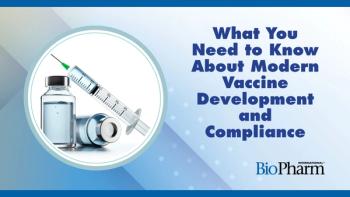
- BioPharm International-03-01-2014
- Volume 27
- Issue 3
European Union Packaging Safety Features Come into Effect
Manufacturers are taking measures to comply with new package safety rules.
Compliance with European Union rules on the security of medicines packaging, the last aspect of the EU’s Falsified Medicines Directive (FMD) to come into effect, is now looking likely to be a daunting task for many pharmaceutical manufacturers. A few key items of the required security features have just been revealed by the European Commission, the EU’s Brussels-based executive, although the drawing up of the rules is not due to be completed until the end of the year. Manufacturers will then have three years to prepare for the deadline for their implementation.
The FMD, which was approved in 2011, was introduced to combat the rising number of falsified medicines in the EU. In 2011, almost 30 million counterfeit medicines were seized at EU borders. Meanwhile other important parts of the FMD—like quality controls on imported APIs, regulation of Internet supplies, and strengthening of requirements for wholesalers—are already coming into effect.
Packaging safety requirements
Obligatory safety features on medicines packaging, which enable the verification of the authenticity of the pharmaceuticals along the supply chain through a unique identifier on each pack, are turning out to be one of the most complex provisions of the legislation. The Commission has been delegated to draft the packaging rules after a lengthy consultation exercise among stakeholders. Generic medicines manufacturers have, for example, wanted to be excluded from the principal requirements because of the additional production costs for protecting low-cost drugs that are unlikely to be falsified.
“What’s clear now is that the rules will bring in one of the biggest production changes in the pharmaceutical industry for a long time because for the first time there will be a need to have a unique identifier code on each pack,” explains Craig Stobie, global life sciences manager at Domino Printing Sciences, Cambridge, England, a leading player in the global coding and printing technologies sector for pharmaceuticals.
Among the details of the packaging rules revealed by the commission in January was that the unique identifier would be placed in a 2D barcode. It will comprise a manufacturer code, a serialization number, a national reimbursement number (if necessary), the batch number, and the expiry date.
The medicine authenticity would be guaranteed by an end-to-end verification system so that the drug pack would be scanned at the pharmacy or other dispensing points. Medicines at higher risk of falsification, such as returns or medicines not being distributed directly by manufacturers, will be additionally checked at the wholesaler level.
The nature of the anti-tamper device on each pack will be left to the choice of manufacturers. Also the commission has decided that all prescription medicines, with a few minor exceptions, would have to carry the unique identifier code, including generic drugs.
“The implementation of safety features will add significant costs for low-priced medicines even though only 0.005% of medicines in the EU legal supply chain are alleged to be falsified,” says Maarten van Baelen, medical affairs manager at the European Generic Medicines Association (EGA), Brussels, representing generics manufacturers.
“The EGA has calculated that the upgrading of packaging lines to adopt the Falsified Medicines Directive fully would cost the EU generic medicines industry €1 billion,” he added in an interview with Pharmaceutical Technology.
The exclusion of generic drugs from the unique identifier system is not supported by most other sectors in the European pharmaceutical industry. The European Federation of Pharmaceutical Industries and Associations (EFPIA), Brussels, the main body representing research-based pharmaceutical companies, strongly favors all prescription-only medicines being subject to the same level of security. It argues that introducing safety features on some prescription medicines would shift the threat to those not protected, which would defeat the aim of eliminating the whole counterfeiting problem.
Allowing some products to be unprotected by the unique identifier feature was also sharply criticized by the European Directorate for the Quality of Medicines and Healthcare (EDQM). Such a step would undermine a major objective of the FMD to improve the efficiency of the whole pharmaceutical supply chain throughout Europe, claimed the EDQM, which is part of the Council of Europe and responsible for the European Pharmacopoeia.
Harmonizing standards
Both organizations want an approach that achieves as much harmonization as possible in Europe’s highly complex medicines supply chain. In the 36 countries the EDQM covers, including the EU’s 28 members states, EDQM calculates that there are 17,000 pharmaceutical manufacturers, 22,000 wholesalers and distributors, 170,000 retail pharmacies, 6500 hospital pharmacies, and 4000 internet/mail-order pharmacies.
Both EFPIA and EDQM are involved in the development of separate coding and serialization systems for application across Europe. Along with the main European associations for pharmaceutical wholesalers, parallel traders and distributors and community pharmacists, EFPIA has helped set up the European Stakeholder Model (ESM), which has been undergoing trials in parts of Europe.
“EFPIA has already seen great progress in trials run thus far and is optimistic about the ESM’s ability to advance the EU’s anti-counterfeiting measures,” Andreas Walter, EFPIA’s serialization project director, told Pharmaceutical Technology. In guidance issued to its members in November 2013, the association has told its members to start immediately preparation for compliance with the FMD rules on packaging.
“Overall we can conclude that early adopters--those who comply sooner with the FMD in the ESM framework--have a definite advantage,” Walter says. “If everyone starts at the same time after publication of (the rules), there will be a problem with the availability of service providers for the packaging lines, which must all be modified in only three years.”
The EGA has pointed out the difficulties of upgrading an estimated 10,000 packaging lines serving the European generics market, which accounts for half of all pharmaceutical sales by volume. “In order to ensure continuity of supply of medicines, it is necessary to upgrade lines in a highly controlled manner,” says van Baelen. “Commercial providers of printers, scanners, and serialization software have expressed concerns that they will not have the hardware and human resources to upgrade all these lines by 2018.”
The EGA is calling for a phased-in approach to the implementation of the serialization rules, starting with high-priced and other products with the most risk of falsification.
“By starting small and solving any arising complications on a small scale, continuity of supply of affordable medicines will be less at risk, much of the cost can be spread over time, and the credibility of the control system can be maintained,” explains van Baelen.
Printing quality
In ESM coding guidelines published last June, EFPIA warned that the success or failure of its system would be determined by the printing quality of the codes. “In addition to selecting the most appropriate printing technology, this requires manufacturers to ensure that the pack carton is suitable,” EFPIA says. “(This means ensuring) that the appropriate substrate is selected, that varnish-free areas are available, and that there is enough free space on the artwork.”
Domino stresses that the quality of the printing of the code can depend on a number of players in the supply chain, which will now have to work together effectively to enable the end-to-end verification of a unique identifier system to operate properly. “The supply chain can include not just the ink producers and the manufacturers of the inkjet or laser equipment but also the makers of the cartons and the carton board,” says Stobie. “If the carton board is not white enough the ink may have insufficient clarity and blackness.”
The quality of the ink and printing will be crucial for products, which could be in the supply chain for as long as two years because of Europe’s intricate distribution network for medicines. “If ink deteriorates due to high or low temperatures or moisture in storage facilities the scanning of individual products at the dispensing point in pharmacies will fail,” Stobie explains.
The FMD serialization scheme when it is operating fully will be scanning 17 billion prescription medicines per annum, according to EGA estimates. “A 0.1% error rate would equal 17 million undispensed boxes per year or 46,575 boxes per day,” says van Baelen. “One third of pharmacies in Europe would see an error per day.”
Tests of a serialization system called securPharm in Germany, which involves 400 pharmacies and 100 products, were still recording a 5% error rate at the end of last year after an original error level of 30%, according to EGA.
Clearly once the FMD packaging rules start to come into force in 2018--seven years after the approval of the directive--the rules will still take time to provide a firm basis for a smooth and efficient process for end-to-end product verification.
About the Author
Sean Milmo is a freelance writer based in Essex, UK,
Articles in this issue
almost 12 years ago
Manufacturers Struggle with Breakthrough Drug Developmentalmost 12 years ago
Regulators Get Tough on Corruption in Chinaalmost 12 years ago
UPLC System for Nano- to Microscale Separationsalmost 12 years ago
Predicting Lyophilization Performancealmost 12 years ago
ALpHA G Capsule Filter for Single-Use Systemsalmost 12 years ago
Design of Experiments for Analytical Method Development and Validationalmost 12 years ago
Under New OwnershipNewsletter
Stay at the forefront of biopharmaceutical innovation—subscribe to BioPharm International for expert insights on drug development, manufacturing, compliance, and more.





